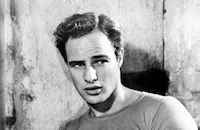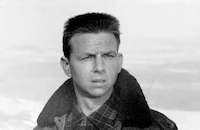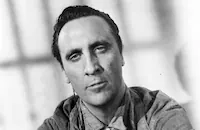The Wild One

Brief Synopsis
Cast & Crew
Laslo Benedek
Marlon Brando
Mary Murphy
Robert Keith
Lee Marvin
Jay C. Flippen
Film Details
Technical Specs

Synopsis
A gang of ruffian motorcyclists led by Johnny Straibler roar into the town of Carbonville, disrupting a local motorcycle race. The gang mocks the proceedings and Johnny steals a little trophy meant for the winner before the gang rides off to the next small town. While drag racing on the main street, the gang causes a minor accident which upsets many of the locals, who watch uneasily as the bikers settle into Bleeker's Café. Johnny is attracted to Kathie Bleeker, a quiet, practical girl who works at the café for her uncle Frank.
Johnny shows Kathie the racing trophy, implying that he has won the event. Fascinated and a little frightened by Johnny's brooding intensity, Kathie is nevertheless taken aback when he offers her the trophy and turns down his offer to dance to the loud jukebox music. The town residents grow increasingly disturbed as several gang members harass locals and continue their flippant and dangerous bike antics. Harry Bleeker, the town's aging, solitary policeman, comes into the café to speak with Johnny, who is annoyed to discover that Harry is Kathie's father. Johnny gathers his gang together and considers pulling out of town when a rival bike gang led by Chino arrives. Chino harbors a grudge against Johnny for breaking away from their once unified gang.
Visibly drunk, Chino ridicules the racing trophy and reveals that Johnny stole it, which disappoints Kathie, who is listening from the café. A brawl breaks out between Johnny and Chino, prompting town resident Charlie Thomas to lament that the violence is allowed to go unchecked. When Thomas attempts to drive through the fray, Chino gets his gang to overturn his car. Harry finally breaks up the fracas and demands that the gangs leave town. When they refuse, Harry arrests Chino for the assault on Thomas. Johnny returns to the café to see Kathie, who avoids him and turns down his invitation to attend a dance in Carbonville. As night falls, members of Johnny's gang convince him to break Chino out of jail.
The gang cuts the phone lines, then picks up Thomas at his home and locks him in the jail cell, where the drunken Chino remains passed out. The gang returns to Bleeker's to drink heavily and carouse as Johnny watches indifferently. Growing anxious by the biker's behavior, Frank sends Kathie for Harry when he discovers the phone is dead. Several exuberant gang members begin looting stores and when a group of them notices Kathie hurrying from the café, they follow on their bikes, cornering her in an alley before Johnny intervenes and drives her to a secluded spot just outside of town. A group of townsmen then break Thomas out of jail, and when Chino awakens, he stumbles out of the cell and rejoins his gang.
Meanwhile, alone with Kathie, Johnny roughly kisses her, but is disturbed by her unexpected submission. He grows angry when she admits to falling in love with him and accuses him of being afraid. After a terse quarrel with Johnny, Kathie walks back into town to discover that the gang has set fire to a building. Johnny follows, but confused by Kathie's declaration and now repelled by the gang's raucous behavior, abruptly decides to leave only to be caught by the angry townsmen led by Thomas. Kathie hurries home to find Harry drinking, fearful of the escalating situation in town. Thomas and the townsmen take Johnny to the basement of a store where they take turns beating him, until Harry, encouraged by Kathie, confronts them.
Johnny breaks away and attempts to flee on his bike, but as he speeds down the street, a townsman hurls a wrench at him, causing Johnny to fall and the bike to careen into an old man, killing him. As the community stands about stunned, the county sheriff and several officers drive into town and arrest a number of gang members. The next day Johnny is brought before the sheriff, but refuses to explain the bike accident until Frank reveals the truth. Johnny is set free after the sheriff chastises him for his carelessness, which allowed the situation to get out of control. The remaining gang members are warned to curb their behavior and ordered to leave town. Johnny stops by Bleeker's to return the trophy to Kathie before departing.

Director

Laslo Benedek
Cast

Marlon Brando

Mary Murphy

Robert Keith

Lee Marvin

Jay C. Flippen
Peggy Maley
Hugh Sanders

Ray Teal
John Brown

Will Wright
Robert Osterloh
William Vedder
Yvonne Doughty
Robert Bice
Keith Clarke

Gil Stratton Jr.
Darren Dublin
Johnny Tarangelo

Jerry Paris
Gene Peterson

Alvy Moore
Harry Landers
Jim Connell
Don Anderson
Angela Stevens
Bruno Vesoto
Pat O'malley

Timothy Carey
Joe Haworth
Kenneth L. Smith

Nicky Blair
Norman Budd
Pepe Hern
Sam Gilman
Cris Alcaide
Patrick Miller
Mort Mills
Robert Anderson
Ted Cooper
Frank Hagney

John Doucette
Jerry O'sullivan
Myron Welton
Charles Cirillo

Eve March
Mary Newton
George Dockstader
Dude Criswell
Don Fera
Wally Albright
Kathleen O'malley
Jack Gargan
Crew
Al Clark
George Cooper
Louis Diage
Paul Donnelly
Walter Holscher
Stanley Kramer
Hal Mohr
John Paxton
Rudolph Sternad
Leith Stevens
Morris Stoloff

Photo Collections
Videos
Movie Clip




Hosted Intro
Film Details
Technical Specs

Articles
Behind the Camera (11/2)
Marlon Brando was not enthusiastic about making The Wild One. He reportedly took the role only out of respect for Stanley Kramer, the producer of Brando's film debut, The Men (1950).
To prepare for his role in The Wild One, Marlon Brando renewed his love for motorcycles, practicing his cycling technique and selecting his own wardrobe, which he wore to and from the studio. Brando also spent time with the real-life biker gangs to absorb their mannerisms and speech.
Lee Marvin was cast as a substitute for Keenan Wynn, whom MGM had refused to release after he'd already spent weeks in pre-production on The Wild One. Marvin proved to be a natural in the role; he was actually drunk in several of his scenes, and his on-screen rivalry with Marlon Brando continued off-camera as well.
Many actual biker gang members were hired by producer Stanley Kramer to play themselves in The Wild One. When Kramer asked one of them what they were rebelling against, one cyclist cracked, "Well, what ya got?" That was incorporated into the script and became one of the film's most quoted lines.
Columbia Studios chief Harry Cohn imposed a strict shooting schedule on The Wild One with little time for changes or revisions, much as he had done with a previous Columbia picture, From Here to Eternity (1953).
by Scott McGee

Behind the Camera (11/2)
The Wild One
Marlon Brando, who had impressed critics with his film debut as an embittered paraplegic in a previous Stanley Kramer production, The Men (1950), was cast in the lead role of Johnny, the leader of the Black Rebel Motorcycle Club. In preparing for his role, he brushed up on motorcycling technique so he could do his own riding and selected his own wardrobe of boots, jeans, leather jacket and cap which he wore to and from the studio.
In the biography, Stanley Kramer: Filmmaker by Donald Spoto, the director said, "I gathered together a band of motorcyclists...Brando and I talked to them, and then the writer Ben Maddow was brought in. But he was subpoenaed by the House Un-American Activities Committee so John Paxton took over the script. These guys were a new breed, and there weren't many of them around...A lot of the dialogue is taken from our actual conversations with them. All the talk about "We gotta go, that's all...just gotta move on' was something we heard over and over again. And one of the most famous lines in the film came from my conversation with them too. I asked one of the kids, 'What are you rebelling against?' and he answered, 'What have you got?'"
Due to the subject matter, Kramer had numerous problems with the studio over dialogue and specific scenes that were deemed unacceptable by the Breen office (Hollywood's self-imposed censorship board). Columbia studio boss Harry Cohn hated the completed film but so did Brando for different reasons. The latter said, "We started out to do something worthwhile, to explain the psychology of the hipster. But somewhere along the way we went off the track. The result was that instead of finding why young people tend to bunch into groups that seek expression, all that we did was show the violence."
Audiences, however, felt differently and The Wild One is now seen as a remarkable social document from the Eisenhower era that heralded the arrival of a new subculture. The film was the first in a long line of rebel protagonists that would continue with James Dean in Rebel Without a Cause (1955), Elvis Presley in Jailhouse Rock (1957), and sixties biker films like The Wild Angels (1966) and Easy Rider (1969). The Wild One would also have a profound influence on underground filmmaker Kenneth Anger and his motorcycle fetish film, Scorpio Rising, 1964 (In one scene, a biker prepares for his evening ride by watching The Wild One on television).
Director: Laszlo Benedek
Producer: Stanley Kramer
Screenplay: Ben Maddow (uncredited), John Paxton, based on the novel "The Cyclists' Raid" by Frank Rooney
Cinematography: Hal Mohr
Editor: Al Clark
Art Direction: Walter Holscher
Music: Leith Stevens
Cast: Marlon Brando (Johnny Strabler/Narrator), Mary Murphy (Kathie Bleeker), Robert Keith (Sheriff Harry Bleeker), Lee Marvin (Chino), Jay C. Flippen (Sheriff Singer), Peggy Maley (Mildred).
BW-80m. Closed captioning.
by Jeff Stafford
The Wild One
Quotes
What are you someone that makes sandwiches or something?- Johnny
What're you rebelling against, Johnny?- Girl
Whaddya got?- Johnny
I wish I was going someplace. I wish you were going someplace. We could go together.- Kathie
I don't get you. I don't get your act at all and I don't think you do either. I don't think you know what you're trying to do or how to go about it. I think you're stupid. Real stupid and real lucky. Last night you scraped by, just barely, but a man's dead on account of something you let get started even though you didn't start it.- Sheriff Stew Singer
I've seen hoodlums like this before. If you don't get tough with them the minute they get out of line you're sunk. You're the cop, aren't you? If you can't boot these jerks out there's plenty of us can, even if we have to bust a few heads.- Charlie Thomas
Trivia
This film was banned in Britain until 1968.
Marlon Brando and most of the Black Rebels ride Triumphs and other British motorcycles, while Lee Marvin and his boys ride Harley-Davidsons.
The Triumph motorcycle that Marlon Brando rides in the movie was his personal bike.
San Francisco Hell's Angels chapter president Frank Sadilek bought the striped shirt that Lee Marvin wore in the movie, and wore it when meeting police officials.
Lee Marvin based his character, Chino, on real biker "Wino Willy" Forkner. Forkner rode with the Booze Fighters Motorcycle Club, and is considered a legend among bikers.
Notes
The working titles of this film were The Cyclists' Raid and Hot Blood. The following written prologue appears in the onscreen credits: "This is a shocking story. It could never take place in most American towns-but it did in this one. It is a public challenge not to let it happen again." Frank Rooney's story was based upon an article in Harper's, reporting an incident that happened in the small northern California town of Hollister on Independence Day weekend 1947 when the town was over-run by a gang of outlaw motorcyclists, members of two Los Angeles gangs known as the Booze Fighters and the Nomads. Although three counties sent squads of sheriffs to subdue the drunken bikers, the article claimed there was no violence except among the bikers themselves. According to a February 1953 Hollywood Reporter news item, portions of the film were shot at a ranch near Calabasas, CA.
A June 1951 Hollywood Reporter news item reported that producer Stanley Kramer assigned Edward and Edna Anhalt as associate producers. However, no further information regarding their participation has been found. According to information in the file on the film in the MPAA/PCA Collection at the AMPAS Library, the original script for The Wild One was rejected in early December 1952 on the grounds that it was "a story of violence and lawlessness to such a degree (that it is)... anti-social." Less than one week later, however, PCA head Joseph I. Breen gave tentative approval to a new script. A February 1953 item by columnist Louella Parsons indicated that the PCA would not allow producer Stanley Kramer to release the film abroad. The PCA denied the allegation, claiming it had neither "the authority or inclination" to do so. The film was subsequently banned in England in 1955. Marlon Brando, who was billed above the title, received critical acclaim for The Wild One; the New York Times praised his characterization as appropriately "vicious and relentless," Hollywood Reporter noted his "tremendous, powerful performance" and Variety observed that his "intensity...gets all possible out of the character." Brando's leather jacket, rolled up jeans and biker-boot look from the film has since become an iconic image representing the era's preoccupation with teenage delinquency and typified by the film's famous exchange when a matron asks Brando's character what he is rebelling against and he replies "What d'ya got?"

Miscellaneous Notes
Released in United States 1996
Released in United States 1999
Released in United States Winter December 1953
Filmed with Garutso Balanced Lens.
Shot in 1953.
Released in United States 1996 (Shown in New York City (American Museum of the Moving Image) as part of program "The Essential Brando" March 16 - April 7, 1996.)
Released in United States 1999 (Shown in New York City (Film Forum) as part of program "Columbia 75" November 19 - January 13, 1999.)
Released in United States Winter December 1953














